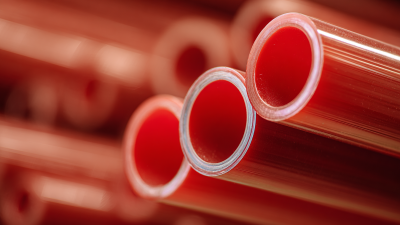Leave Your Message
In the rapidly evolving landscape of modern packaging, the humble Toothpaste Tube has emerged as a focal point for innovation and sustainability. As consumer preferences shift towards environmentally friendly solutions, the design and functionality of these tubes are being reimagined to meet both performance and ecological standards. This blog delves into the innovative solutions that are transforming Toothpaste Tube applications, exploring not only the technological advancements that enhance user experience but also the sustainable materials and methods that minimize environmental impact.

By examining the reasons behind these developments, we will illustrate how the industry is not only addressing consumer demands but also paving the way for a more responsible approach to packaging in the oral care sector. Join us as we uncover the exciting possibilities that lie ahead for Toothpaste Tube innovations.
The design of traditional toothpaste tubes faces several challenges that have implications for both usability and sustainability. According to a recent report by Smithers Pira, the global toothpaste market is projected to reach $26 billion by 2025, which places immense pressure on manufacturers to innovate product packaging. Traditional tubes are often made from non-recyclable materials like laminate, complicating waste management and recycling efforts. As consumers increasingly seek eco-friendly products, the limitations of conventional tube designs are becoming more apparent.
Additionally, traditional toothpaste tubes pose issues related to product accessibility and wastage. Industry studies indicate that approximately 10-15% of toothpaste is left in the tube due to design inefficiencies, leading to both consumer frustration and increased resource consumption. In response to these challenges, innovative packaging solutions such as squeezable bottles, refillable containers, and biodegradable materials are on the rise. These alternatives not only reduce waste but also enhance user experience by enabling more complete product retrieval, thereby aligning with growing market demands for both functionality and sustainability.

As the demand for sustainable products rises, the toothpaste packaging industry is beginning to shift towards eco-friendly materials. Traditional toothpaste tubes are primarily made from a combination of plastic and aluminum, materials that are often non-recyclable and harmful to the environment. To address this issue, manufacturers are exploring alternatives such as biodegradable plastics and compostable materials that can significantly reduce ecological footprints. Innovating with the use of natural fibers, such as paper or plant-based polymers, could lead to packaging solutions that not only protect the contents effectively but also decompose naturally after use.
Moreover, the integration of sustainable materials into toothpaste packaging comes with the added benefit of enhancing consumer perception and brand loyalty. Brands that prioritize environmentally friendly practices are increasingly appealing to eco-conscious consumers who are willing to invest in products that align with their values. By adopting sustainable packaging solutions, companies not only mitigate environmental impact but also position themselves as leaders in the wellness industry. As we look to the future, the evolution of toothpaste packaging towards sustainable materials reflects a broader commitment to creating a healthier planet for generations to come.
As consumers increasingly prioritize convenience and sustainability, innovative dispensing solutions for toothpaste tubes are becoming a significant focal point in modern packaging. According to a report by Smithers Pira, the global toothpaste market is projected to reach $25 billion by 2025, emphasizing the importance of developing user-friendly packaging solutions that cater to consumer demands. Innovative designs such as flip-top dispensers and squeeze tubes with one-handed operation are making it easier for users to control the amount of product dispensed, thereby reducing waste and enhancing the user experience.
Additionally, the integration of smart packaging technology is reshaping how consumers interact with toothpaste. Smart tubes equipped with sensors can notify users when they are running low or provide reminders for proper oral care routines. A study from Packaging Innovations noted that 30% of consumers are willing to pay more for packaging that offers enhanced convenience features. This shift towards smart and multifunctional packaging not only fosters brand loyalty but also aligns with the growing eco-friendly trend, as many of these solutions are designed to minimize plastic waste and improve recyclability.
This chart illustrates the percentage distribution of different innovative dispensing solutions for toothpaste packaging in 2023. The data highlights the growing preference for convenience-oriented designs among consumers.
Modern packaging solutions are crucial in enhancing the shelf life of toothpaste, addressing the common problem of product degradation over time. According to a recent report by Smithers Pira, advancements in packaging materials could potentially extend shelf life by up to 50%, primarily through barriers that protect against moisture, light, and oxygen. These elements are vital in preserving the efficacy of active ingredients within toothpaste formulations.
Innovative designs, such as vacuum-sealed tubes or those utilizing high-barrier materials like EVOH (ethylene vinyl alcohol), have been shown to significantly reduce air ingress. A study published in the *Journal of Packaging Technology and Research* highlights that such materials reduce the permeation of contaminants by over 90%. This not only ensures the toothpaste maintains its quality but also enhances consumer confidence in product longevity. As manufacturers shift towards sustainable packaging solutions, incorporating these advanced technologies will not only preserve product integrity but also align with growing environmental concerns, ultimately benefiting both consumers and the industry alike.
| Packaging Type | Material | Shelf Life (Months) | Moisture Barrier (g/m²/day) | Oxygen Barrier (cm³/m²/day) |
|---|---|---|---|---|
| Plastic Tube | PP (Polypropylene) | 24 | 0.5 | 10 |
| Aluminum Tube | Aluminum | 30 | 0.2 | 5 |
| Composite Tube | PE/Al/PE | 36 | 0.3 | 8 |
| Stand-Up Pouch | PET/AL/PE | 18 | 0.4 | 7 |
| Bio-Based Tube | PLA (Polylactic Acid) | 12 | 0.6 | 12 |
Consumer preferences are fundamentally shaping the evolution of toothpaste tube designs, with a notable shift toward sustainability and convenience. According to a report by Smithers Pira, the global toothpaste market is projected to reach $22 billion by 2025, with an increasing emphasis on eco-friendly packaging options. This demand is driving manufacturers to innovate with materials like biodegradable plastics and recyclable options, which not only appeal to environmentally conscious consumers but also comply with stricter regulations on plastic waste.

Moreover, the convenience factor cannot be overlooked as more consumers favor tubes that facilitate easy dispensing and minimize product waste. As revealed in a survey by Mintel, around 64% of consumers express a preference for packaging that allows them to squeeze out every last drop, indicating a desire for functional design in daily-use products. Innovations such as stand-up tubes and airless dispensers are becoming more prevalent, as they cater to these preferences while enhancing the overall user experience. The intersection of sustainability and consumer convenience is clearly driving the modern evolution of toothpaste tubes, setting new standards for the industry.






